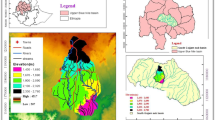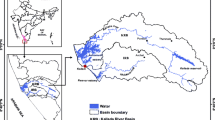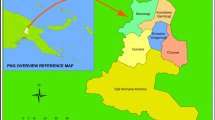Abstract
Present research work is carried out in the Atrai–Sib river basin in the drought-prone but agro-based Barind area in the north-west of Bangladesh to delineate the groundwater potential zones using integrated approach of remote sensing (RS) and geographic information system (GIS)-based multi-criteria evaluation. Decreasing trend in rainfall along with increasing population in this drought-prone area calls for a sustainable development of the groundwater resource. The river basin possesses dendritic drainage pattern and major portion of runoff water allows more infiltration to recharge the groundwater and is, therefore, a potential for groundwater occurrence. The gentle to flat river basin is of ‘excellent’ category for groundwater management because of favorable infiltration to maximum time of runoff percolation. Here, seven different thematic layers such as, geomorphology, drainage density, rainfall, lithology, lineament density, slope and land use/ land cover (LULC) are integrated in GIS environment to study groundwater potentiality. Corresponding normalized rates for the classes in a layer and weights for the thematic layers are computed using Saaty’s Analytical Hierarchy Process (AHP), and then aggregated thematic map is prepared using a weighted linear combination (WLC) method. Map-removal and single-parameter sensitivity analysis are used to examine the effects of removing any thematic layer on the groundwater potential zones and to compute effective weight, respectively. About 226 km2 (6% of the study area) is designated as very good groundwater potential zone, whereas that of good, moderate, very poor and poor groundwater potential zones cover 407 km2 (11%), 720 km2 (19%), 997 km2 (26%) and 1418 km2 (38%), respectively. Sensitivity analysis shows that the groundwater potential zonation in the study area is most sensitive to lineament density (mean variation index 2.66), which is the most effective thematic layer in the groundwater potentiality zone (mean effective weight of 27.13%) and supports the need for future river basin development and management. This study can help to identify the groundwater potential zones of this drought-prone area that will lead towards the planning of the integrated water resources management.










Similar content being viewed by others
References
Adiat KAN, Nawawi MNM, Abdullah K (2012) Assessing the accuracy of GIS-based elementary multi criteria decision analysis as a spatial tool-A case of predicting potential zones of sustainable groundwater resource. J Hydrol 440–441:75–89
Alam MS (1998) Paleoclimatic impact on the flood basin accretion and paleosol development in northwestern Bangladesh. J Nepal Geol Soc 18:227–238
Alexander D (1995) Changing perspectives on natural hazards in Bangladesh. Nat Hazards Obs 10(1):1–2
Avtar R, Sing CK, Shashtri S, Sing A, Mukherjee S (2010) Identification and analysis of groundwater potential zones in Ken-Betwa river linking area using remote sensing and geographic information system. Geocarto Int 25(5):379–396
Ayazi MH, Pirasteh S, Rizvi SM, Safari H, Ramli FM, Pradhan B, Rizvi SM (2010) Using ERS-1 synthetic aperture radar for flood delineation, Bhuj Taluk, Kuchch District Gujarat, India. Int Geoinform Res Dev J 1:13–22
Ayele AF, Addis K, Tesfamichael G, Gebrerufael H (2015) Spatial analysis of groundwater potential using remote sensing and GIS based multi-criteria evaluation in Raya valley, Northern Ethiopia. Hydrogeol J 23:195–206. https://doi.org/10.1007/s10040-014-1198
Berhanu B, Melesse AM, Seleshi Y (2013) GIS-based hydrological zones and soil geo-database of Ethiopia. Catena 104:21–31
Bhuvaneswaran C, Ganesh A, Nevedita S (2015) Spatial analysis of groundwater potential zones using remote sensing, GIS and MIF techniques in upper Odai sub-watershed, Nandiyar, Cauvery basin, Tamil Nadu, India. Int J Curr Res 7(09):20765–20774
Brammer H (1996) The geography of the soils of Bangladesh, 1st edn, The University Press Limited, Dhaka, Bangladesh
Chowdhury A, Jha MK, Chowdhury VM, Mal BC (2009) Integrated remote sensing and GIS-based approach for assessing groundwater potential in West Mednapur district, West Bengal, India. Int J Remote Sens 30(1):231–250
De Villiers M (2000) Water: the fate of our most precious resource. Mariner Books, Houghton
Dev SG (2015) Groundwater potential map** of Sihu river watershed area of Mahoba District, UP using Remote Sensing and GIS. Int J Adv Res 1(10):241–248
Fashae OA, Tijani MN, Talabi AO, Adedeji OI (2014) Delineation of groundwater potential zones in the crystalline basement terrain of SW-Nigeria: an integrated GIS and remote sensing approach. Appl Water Sci 4(1):19–38
Fennta AA, Kifle A, Hailu G, Gebreyohannes T (2015) Spatial analysis of groundwater potential using remote sensing and GIS-based multi-criteria evaluation in Raya, Northern Ethiopia. Hydrogeol J 23:195–206
Gafoor MA (1982) Use of Landsat Data for Monitoring the Change of Teesta River Course. In: Proceeding of Second Asian Conference Remote Sensing, Bei**g, China, Oct. 29-Nov. 4
Gaur S, Chahar BR, Graillot D (2011) Combined use of groundwater modeling and potential zone analysis for management of groundwater. Int J Appl Earth Obs Geoinf 13(1):127–139
Gogu RC, Carabin G, Hallet V, Peters V, Dassargues A (2001) GIS-based hydrogeological databases and groundwater modeling. Hydrogeol J 9:555–569
Goodchild MF (1993) The state of GIS for environmental problem solving. In: Goodchild MF, Parks BO, Steyaert LT (eds) Environmental modeling with GIS
Gossel W, Ebraheem AM, Wycisk P (2004) A very large scale GIS-based groundwater flow model for the Nubian sandstone aquifer in Eastern Sahara (Egypt, northern Sudan and eastern Libya). Hydrogeol J 12(6):698–713
Hammouri N, El-Naqa A, Barakat M (2012) An integrated approach to groundwater exploration using remote sensing and geographic information system. J Water Res Prot 4:717–724
Hirst Major FC (1917) Report of the Nadia Rivers, The Bengal Secretariat Book report, Calcutta
IWM (Institute of Water Modelling) (2006) Groundwater Model Study for Deep Tube well Installation Project in Barind Area. Final Report, Volume-I (Main Report)
Jahan CS, Ahmed M (1997) Flow of groundwater in the Barind area, Bangladesh: implication of structural framework. J Geol Soc India 50:743–752
Jahan CS, Mazumder QH, Islam TMM (2008) Impact Evaluation of an Irrigation Project Based on Meteorological Data and Groundwater Hydrograph: A Case Study of BIADP, NW Bangladesh. Published in the Proceedings of the XXXIX IAH Congress (IAH 2008), Toyama, Japan. Held on 26 October to 1 November 2008
Jahan CS, Mazumder QH, Islam AMM, Adham MI (2010) Impact of irrigation in Barind Area, NW Bangladesh—an evaluation based on the meteorological parameters and fluctuation trend in groundwater table. J Geol Soc India 76:134–142
Jahan CS, Rahman ATMS., Mazumder QH, Kamruzzaman M (2015) Adaptation for climate change effect on groundwater resource through MAR technique in drought prone barind area, Rural Bangladesh. In Ali SM (ed), Bangladesh: combating land degradation and drought (pp 61–83). Dhaka: Series-II, Department of Environment (DoE), Ministry of Environment (MoEF), Government of Bangladesh. ISBN 978-984-33-9991-5
Jaiswal RK, Mukherjee S, Krishnamurthy J, Saxena R (2003) Role of remote sensing and GIS techniques for generation of groundwater prospect zone towards rural development: an approach. Int J Remote Sens 24(5):993–1008
Khandoker RA (1987) Origin of elevated Barind Madhupur areas, Bengal Basin: results of neotectonic activities. Bangladesh J Geol 6:1–9
Lodwick WA, Monson W, Svoboda L (1990) Attribute error and sensitivity analysis of map operations in geographical information systems: suitability analysis. Int J Geogr Inf Syst 4(4):413–428
Lu YC, Daughtry C, Hart G, Watkins B (1997) The current state of precision farming. Food Rev Int 13(2):141–162. https://doi.org/10.1080/87559129709541104
Machiwal D, Jha MK, Mal BC (2011) Assessment of groundwater potential in a semiarid region of India using remote sensing, GIS and MCDM techniques. Water Resour Manag 25(5):1359–1386
Mark DM (1984) Automatic detection of drainage networks from digital elevation models. Cartographica 21:168–178
Morgan JP, McIntire WG (1959) Quaternary geology of the Bengal Basin, East Pakistan and India. Geol Soc Am Bull 70:319–342
Napolitano P, Fabbri AG (1996) Single parameter sensitivity analysis for aquifer vulnerability assessment using DRASTIC and SINTACS. In: Kovar K, Nachtnebel HP (eds) Proc. Hydro. GIS: application of geographical information systems in hydrology and water resources management, IAHS Publ. 235. IAHS, Wallingford, pp 559–566
Rahman ATMS., Jahan CS, Mazumder QH, Kamruzzaman M, Hossain A (2016) Evaluation of spatio-temporal dynamics of water table in NW Bangladesh—an integrated approach of GIS and statistics. Sustain Water Resour Manag 2(3):297–312. https://doi.org/10.1007/s40899-016-0057-4
Rao YS, Jugran DK (2003) Delineation of groundwater potential zones and zones of groundwater quality suitable for domestic purposes using remote sensing and GIS. Hydrol Sci J 48(5):821–833
Rose RS, Krishnan N (2009) Spatial analysis of groundwater potential using remote sensing and GIS in the Kanyakumari and Nambiyar basins, India. J Indian Soc Remote Sens 37(4):681–692
Saaty TL (1980) The analytic hierarchy process. McGraw-Hill, New York, p 278
Sener E, Davraz A, Ozcelik M (2005) An integration of GIS and remote sensing in groundwater investigations: a case study in Burdur, Turkey. Hydrogeol J 13(5–6):826–834
Singh A (2014) Groundwater resources management through the applications of simulation modeling: a review. Sci Total Environ 499:414–423
Sisay L (2007) Application of remote sensing and GIS for groundwater potential zone map** in Northern Ada’a plain (Modjo catchment) University Publisher, Addis Ababa University. http://etd.aau.edu.et/dspace/handle/123456789/386
Sleight VA, Thorne MA, Peck LS, Arivalagan J, Berland S, Marie A, Clark MS (2016) Characterization of the mantle transcriptome and biomineralisation genes in the blunt-gaper clam, Mya Truncata. Mar Genom 27:47–55. https://doi.org/10.1016/j.margen.2016.01.003
Smith KG (1950) Standards for grading texture of erosional topography. Am J Sci 248:65–668
Soumen D (2014) Delineation of ground water prospect zones using remote sensing, GIS techniques—a case study of Baghmundi development block of Puruliya district, West Bengal. Int J Geol Earth Environ Sci 4(2):62–72, ISSN: 2277–2081 (online). An open access, online international journal available at http://www.cibtech.org/ jgee.htm
Sreedhar G, Kumar GT, Krishna IV, Ercan K, Cuneyd DM (2009) Map** of ground water potential zones in the Musi basin using remote sensing data and GIS. Adv Eng Softw 40:506–518
Stafford KW, Rosales-Lagarde L, Boston PJ (2008) Castile evaporate karst potential map of the Gypsum Plain, Eddy County, New Mexico and Culberson County, Texas: a GIS methodological comparison. J Cave Karst Stud 70(1):35–46
Strahler AN (1964) Quantitative geomorphology of drainage basins and channel networks. In: Te Chow Ven. (ed) Hand book of applied hydrology. McGraw Hill Book Company, New York
Tarboton DG (1997) A new method for the determination of flow directions and contributing areas in grid digital elevation models. Water Resour Res 33:309–319
Terzer S, Wassenaar LI, Araguás-Araguás LJ, Aggarwal PK (2013) Global isoscapes for d18O and d2H in precipitation: improved prediction using regionalized climatic regression models. Hydrol Earth Syst Sci 17(11):4713–4728
Tesfaye T (2010) Ground water potential evaluation based on integrated GIS and RS techniques in Bilate river catchment, South rift valley of Ethiopia. American Scientific Research Journal for Engineering, Technology and Sciences (ASRJETS). ISSN (Print) 2313–4410, ISSN (Online) 2313–4402
Thomas BC, Kuriakose SL, Jaydev SK (2009) A method for groundwater prospects zonation in data poor areas using remote sensing and GIS: a case study in Kalikavu Panchayth of Malappuram district, Kerala, India. Int J Digital Earth 2(2):155–170
Todd DK, Mays LW (2005) Groundwater hydrology, 3rd edn. Wiley, New York p636
Tsakiris G (2004) Water resources management trends, prospects and limitations. In: Proceedings of the EWRA symposium on water resources management: risks and challenges for the 21st century, 2–4 September 2004, Izmir, pp1-6
Waikar ML, Nilawar AP (2014) Identification of groundwater potential zone using remote sensing and GIS technique. Int J Innov Res Sci Eng Technol 3:(ISSN: 2319–8753)
Author information
Authors and Affiliations
Corresponding author
Rights and permissions
About this article
Cite this article
Jahan, C.S., Rahaman, M.F., Arefin, R. et al. Delineation of groundwater potential zones of Atrai–Sib river basin in north-west Bangladesh using remote sensing and GIS techniques. Sustain. Water Resour. Manag. 5, 689–702 (2019). https://doi.org/10.1007/s40899-018-0240-x
Received:
Accepted:
Published:
Issue Date:
DOI: https://doi.org/10.1007/s40899-018-0240-x




